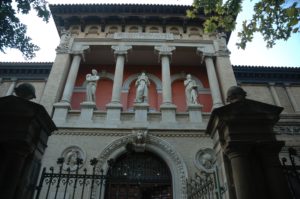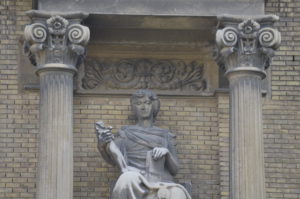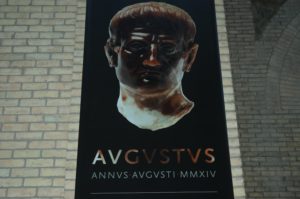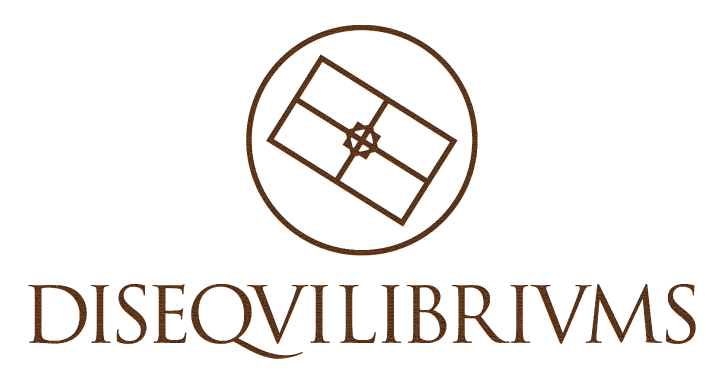DISEQUILIBRIUMS. Part 1. Chapter 6
CHAPTER 6
Thursday 15 December 2016
Time: 10:00

The first thing that strikes you when you enter the Provincial Museum is the enormous hall. It is more than five metres high, lined by tall columns with capitals of the ancient kind which, they told us in class, were decorated with a species of leaves.
“Corinthian, David. Corinthian capitals.” That was always my mother’s response after I asked the same old question whenever I accompanied her.
I never have time to study them because a very kind person on your left would ask if you needed help. Normally, that same person would invite you to go to the left again. There, you would find a counter with a lady primed to give you information about the museum or to guide you to the section you wanted to see. Shelves full of leaflets and books encourage you to find out more before your visit.
This scenario is repeated today.
I know it so well from the many times I’ve come before with my school or with my mum.

Although I am the first to cross the street to enter the museum, it’s Sofia who takes the lead, overtaking me and urging us to follow her. She doesn’t wait for us before going in herself. As she’s always telling us, she doesn’t like wasting time. She leads us straight to the information desk to ask where exactly the Ancient Rome exhibition is.
I wish I was as decisive as her. But I prefer to mull over things before doing anything. As I watch her striding on ahead, I try to guess what she is thinking about, as she turns her head from side to side as tourists do without fully understanding what they are looking at. She probably thinks she’s wasting time. She always says the same thing. I can imagine the words running though her head as if I were in her mind. She’s an unstoppable force.
I’ll never forget when she told me that meditation isn’t her thing. She prefers action even though her mother insisted that one day she will need it. She recounted that her mother had told her: “You are living through a very beautiful period now as you are young, but when you grow up and life becomes intense, you will need to put aside some time for relaxing and reflecting.” On the day she told me this, we were alone. I could scarcely believe it. She allowed me to walk home with her after school. Everything she did thrilled me – how she walked, how she touched her hair, her smile, the shape of her mouth… We were standing waiting for the lights to change, for the cars to stop to let us cross. She began to talk about herself and her childhood. I couldn’t remember how many times the lights changed before we finally moved. It was clearly a sign that she wanted to be with me. I could sense how close she was. The scent of her perfume intoxicated me and made me want to move even closer.
Her long, red curls were flowing in the strong wind that was blowing that day. Her beautiful green eyes stared far into the distance as she spoke, preventing me from meeting her gaze and searching her eyes for that same distant place which was allowing her to open up to me as she had never done before. I couldn’t stop staring at her. She was so beautiful. I would have put my arms around her and kissed her there and then in front of all these people, if it hadn’t been for the fact I didn’t how she would respond.
Suddenly, I realised that I was no longer listening to her. I felt ashamed. How unfair it was not to remember what she had been telling me for the last few minutes. I didn’t know how, but I managed to tear myself away from the part of my mind which was preventing me from following her words and listened to what her lips were actually saying: that, although she didn’t like taking her mother’s advice, she understood and appreciated her point-of-view. She knew what she had to go through with everything that had happened to her husband. “She only wants the best for us…” was the last sentence I remember her saying just before we crossed the street. We said good bye on the other side and headed in opposite directions to our homes.
Now, she attracts me just as much or even more than she did then. But she made her choice and I … have lost! It’s like in the movies: the good-looking bloke always gets the girl, and that was that.
“Come on! Come on! Don’t dawdle.” Sofia’s voice breaks through my inner thoughts as she grabs my right arm and leads me into the inner patio of the museum.
That’s it. I mustn’t dwell on it. It’s time to get down to work.

We’ve been inside the museum for at least five minutes. We cross the inner patio. It looks like a cloister in a monastery with its rectangular floor, six columns along its longer sides and five on each of the shorter ones. I always count them when I’m here, I don’t know why. I look up at the top of the columns and they look like Doric capitals, or is it Ionic? It’s clear that they aren’t the same as the ones at the entrance. The truth is that I can never remember. They explained it all to us at school a couple of years ago, but I have to admit that I still don’t know how to tell them apart. They support the ceiling over the aisle, protecting the works on display from direct sunlight and from any rain that might enter from the central section of the open patio. In reality, the columns support an upper passage which you can just about make out from the small, long and narrow windows above, surrounding the entire patio. I’ve always noticed how they end in a half arch and are decorated at each end by other small columns with their curves superimposed like two Coca Cola bottles, one on top of the other.
But what I like looking at most is the decoration around the whole perimeter above those windows. It is made from dark wood and engraved with such a high degree of detail that I’ve always assumed that they must have been done before they were assembled. Moving around, I can feel the intense cold as I cross the patio. I look up at the sky. I can almost touch the thousands of leaves blown in and out by the persistent wind.
Looking at each side of the rectangle, on the porch side, you can see some of the sculptures or engraved stones which are part of the exhibition. I don’t see anything from the period we’re looking for. Directly ahead of me, Sofia is making for the far end, to the left where great black curtains reveal the entrance to the inner part of the museum they told us about. I follow her. I turn around and see that the others are also close behind. Inwardly, I smile at Sofia’s ability to get others to do what she wants.
My problem is that I couldn’t be objective where she’s concerned. Everything she does is perfect.
As always when I enter this part of the museum, I have to wait a few seconds to get used to the light. In the street, although it’s cold, the sun is shining, but inside it’s very dark.
The first thing we see is a set of mosaics which were found in some houses in the old town during the recent restoration works. I look at Sofia. She obviously knows that this is not what she’s looking for. She quickly turns and heads to the right of the room, completely sure of herself, as if she had decided beforehand what the aim of the visit was going to be.
We gather by her side. I am surrounded by my three companions standing and looking at the display cabinets. There, on display are Roman coins found at Caesaraugusta, the name given to the city by the Romans, and here they are featured everywhere.
I realise that, without thinking, I’ve been following Sofia around like a little lamb. I would have stayed a little longer in the inner patio to see if some of the sculptures could be Roman. She, on the other hand, takes one glance and decides that there’s nothing here. I hope that we aren’t making a mistake and would have to go back afterwards.
“It looks like the teacher wasn’t lying.” Elsa says in a loud voice, getting all of us to peer through the glass. “According to what it says here, the city was founded following a set of special instructions. It was Caesar Augustus himself who took the decision. It was founded exactly on the day of the winter’s solstice and nothing short of 14 BC.”
“Did you say 14 BC?” I ask, slightly alarmed, as I rummage for one of the books I have in my bag.
When at last I get it out and find the page I was looking for, I say:
“You’re not going to believe the coincidence!” I look at all of them in the eye and continue, “Caesar Augustus died in 14 BC.” In silence, I re-read the page, then went on, “According to this, he was 50 years old when the city was founded.”
With an almost authoritarian voice and trying to be in the right, Sofia butts in:
“You seem to be looking for coincidences where there aren’t any. In fact the city was founded on 23rd December and he died on 19th August. In other words, there is no coincidence.”
“I wouldn’t be so sure,” Erik interrupts. Impatiently, Sofia turns her back on him. She doesn’t like being contradicted. However, Erik carries on: “With those dates, perhaps not, but look.” He points at the writing in the display cases. “According to this, the Decumanus was positioned so it was in line with the sunrise on 23rd December.
In other words, Emperor Augustus founded the city around the time of the winter solstice. I couldn’t remember if the teacher had said it the other day in class or if someone somewhere else had mentioned it. I didn’t know why, but this information struck me as both strange and mysterious at the same time. Why did he choose that exact day?
We all read the rest of the text, then go back to where we saw a map of the ancient city. Hanging on the wall, it must be around two metres wide by three metres long. I like it because it’s large enough for at least a group of people like us, standing in front of it, to be able to look at it without any difficulty. What is more, it highlights the various discoveries made in the old town with tiny lights. I can easily make out the two main roads which the Romans drew to start the design.
Sofia looks back at us and puts her finger to her lips. Just then, a group of tourists approach, attentively listening to the explanation of their guide. We understand what Sofia is saying. Unnoticed, we merge with the group, although we haven’t paid for the guided tour.
The guide is a tall woman, with long grey hair worn down her back. She looks around 60 years old and is wearing a long white tunic as if she were in ancient Rome. She points out the city plan to the group and explains in a loud voice the Cardus and the Decumanus, running from north to south and east to west respectively, typical of all cities built by Rome in that era.
She talks about the discoveries in the city on the map: the forum, the thermal springs, the amphitheatre and the walls. She gives a few details in response to some questions. In short, it’s an ordinary explanation in an ordinary museum on an ordinary day. I’m looking at Sofia and notice that she’s looking at the map in a different way. Each time the guide highlights a street, Sofia glances up at the plan again.
It seems that this isn’t going to be an ordinary day after all.
I can see that she’s restless. It looks as if she wants to ask something, but doesn’t. This is strange because nothing usually stops her when she wants to ask something in class or in a group.
The guide goes on explaining the history of how the city was founded.
“… following this founding principle, a priest guided two oxen pulling a golden plough. He would plunge it into the earth to draw the city limits. However, in this particular case…”
Why did she say ‘in this particular case’? I imagine that the Romans did it in every city. Could she have made a mistake? She must have said the same thing so many times that it was normal, totally understandable for her to make a mistake now and again. Or was it? Oh great, I thought to myself, with all this talk of a sacred city, I was starting to see nothing but mysteries wherever I looked.
“… all the earth from the furrow was piled on the inner part where the city would be built, because they understood that this was the earth of the sacred city.” The guide ends her explanation and stands back a little to allow the tourists to get closer to the map.
In essence, it’s the same thing they explained to us in class, but this woman seems to have lived it. She describes it as if she had actually been there. And for a moment I picture her there with her dark eyes and the furrowed skin of her face showing how the sun could leave its mark on someone. She clearly didn’t get that bronze colour working in a museum. I imagine her as a busy heroine, working outdoors day after day in ancient times. Now, she’s a guide in a museum. What would her life have been like then? Here I am at it again – daydreaming. I love imagining that, behind each person, there was a hidden world that only I have the chance to know. She would be the perfect model for my list of mysterious characters when I became a writer.
Well, that’s for another time.
The guide steps forward once, pointing to the plan of the city centre, indicating that the boundary of the old town mapped out by the plough corresponded to the existing streets: Caesar Augustus and Coso. She explains that where the plough was lifted – four times at different points, north, south, east and west – was where gates would be built. Then, she says:
“One of them was called Cinegia Gate and I imagine that you have heard that name if you have passed through the city centre. Another is the East Gate which was later named the Puerta de Valencia (Valencia Gate) where the Church of La Magdalena is now located. To the north, there was another gate which overlooked the bridge over the Ebro River, and to the west, the gate which would later be known as the Puerta de Toledo (Toledo Gate), which ends at the present-day Central Market.”
When she finishes her explanation, she moves to the next exhibition room with the group. We carry on looking at the map, or rather, hang around Sofia as she continues looking at the map.
I turn to see where the group had gone. I see that the guide is going towards another area. Then, she suddenly turns around and see that the group of young people who were looking at the map are missing: us. Without really meaning to, we succeeded in making her think we are part of the group and now she is coming over. She is going to tell us off and perhaps even throw us out of the museum. How embarrassing!
When the guide reaches us, Sofia steps forward, looks at her and says:
“There’s something that I don’t understand.” She stops and looks directly at the guide. “Up to now, we’ve always seen this map of the city centre with the Cardus and the Decumanus intersecting. In class, they told us that Zaragoza was chosen by the Romans for the intersection created by the Gallego and Huerva Rivers as they flowed into the Ebro. The rivers correspond to this north-south and east-west orientation, but if we put this city plan that you have shown us and we orient it correctly, Don Jaime Street and the Calle Mayor…”
Sofia stops and then, looking directly at her, says:
“…do not run either north-south, or east-west.”
There’s silence.
All eyes are fixed on the guide, expecting a snappy response. Sofia never ceases to amaze me. I don’t understand why she asked the question, but I thought the answer would be forthcoming in a matter of seconds.
But it isn’t. We watch in astonishment as the guide turns red but says nothing. She shakes her head from side to side, stopping as soon as she sees that the guard, standing at the entrance of the room, is looking at her. She presses her lips together as if trying to seal her mouth. She looks so nervous.
To break the ice, I say to Sofia in low voice:
“She doesn’t know the answer.”
Sofia gives me a disapproving look. Then, she turns back to the guide. We are all waiting for her answer. She then surprises us again because, without saying a word, she turns on her heels and walks back to her group. The four of us look at each other with puzzled expressions, not knowing what just happened. Without much ado, we continue our visit through the museum to finish our class assignment.
The rest of the exhibition isn’t as interesting. We keep on walking briskly through the aisles.
At last, our visit comes to an end. Sofia stayed a bit behind us in the inner patio, looking at a monolith apparently from the Roman era. The rest of us stand at the door, waiting for her. Just when we’re about to leave the museum, we all look back at Sofia in the distance. She must have realised that we’re looking at her and looks as if she didn’t understand what we were saying, making the usual hand signals. She finally turns her back to us, I notice her alarm as she sees the guide silently approaching her. She’s looking straight at Sofia, holding out her hand as if bidding her farewell.
Sofia looks surprised by this gesture normally reserved for adults. She responds by offering her own. They shake hands. The guide murmurs something, which we couldn’t hear.
Then, the woman in her white tunic disappears into the interior. Our friend stands transfixed, leaning against one of the columns.
She doesn’t speak, but simply stares at her fist, which, even from a distance, we can make out is clenched around a small piece of white paper, jutting out from the side of her hand.
Writer: Glen Lapson © 2016
English translator: Rose Cartledge
Publisher: Fundacion ECUUP
Project: Disequilibriums
Register on the website www.disequilibriums.com/en/registred and you will receive a notification to allow you to read the chapters as they are published and updates of the project.

No Comments